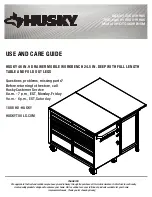
20
Array Type
JBOD: Just a Bunch of Disks
RAID 0: Striping
RAID 1: Mirroring
RAID 5: Rotating Parity bit (Single parity)
RAID 6: Rotating Parity bit (Dual parity)
RAID 10: Striping Mirrored array
RAID 50: Stripping RAID 5 array
Each RAID level has its pros and cons based on the application you use it for (Note: Refer to RAID level
Quick Reference.)
Array Name
Name displayed in Logical Device Information (Default: RAID_<level>_<array number>)
Initialization Method
Initialization of a disk sets all data bits to 0, essentially clearing all the data on the drive. It is important
to initialize disks as previous data physically stored on the drive may interfere with new data.
Keep Old Data: This option skips the initialization process and all data on each physical disk of
the array will be untouched.
Quick Init: This option grants immediate access to the RAID array by skipping the initialization
process, but it will delete all data. Note: Skipping initialization is generally not recommended
as residual data on disks may interfere with new data in the future.
Foreground: The array initialization process will be set at high priority. During this time array
is not accessible, but the initialization process will complete much faster.
Background: The array initialization process will have a lower priority. During this time the
array will be accessible, but the initialization process will take much longer to complete.
Note:
Initializing takes a significant amount of time (approximately 2 hours per one TB).
Fully initializing the array will completely zero out the data on the disks, meaning the disk will
be completely wiped and every bit on the disk will be set to 0. Foregoing initialization means
the array will still be created, and you can still write new data onto the array. But when your
array requires rebuilding, residual data left behind may interfere with the process.
Cache Policy (Default: Write Back)
Write Back:
Any data written to the array will be stored as cache, resulting in better I/O performance at
the risk of data failures due to power outages. Data will be stored as cache before it is
physically written to the disk; when a power outage occurs, any data in the cache will be lost.
Write Through:
Data written to an array is directly written onto the disk, meaning lower write performance
for higher data availability. Without cache acting as a buffer, write performance will be
noticeably slower but data loss due to power outages or other failures is significantly
minimized.
Block Size (default: 512K)
Adjusting the block size towards your disk usage can result in some performance gain.
In a typical RAID configuration, data of the virtual drive is striped (or spread across) the physical
drives. Having a smaller array block size will increase the likelihood of accessing all physical drives
















































